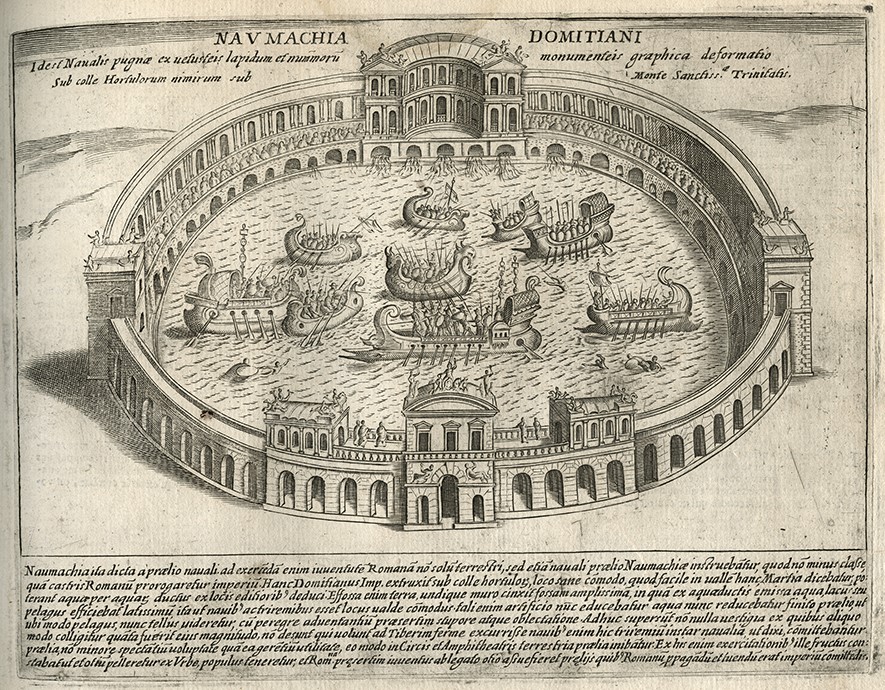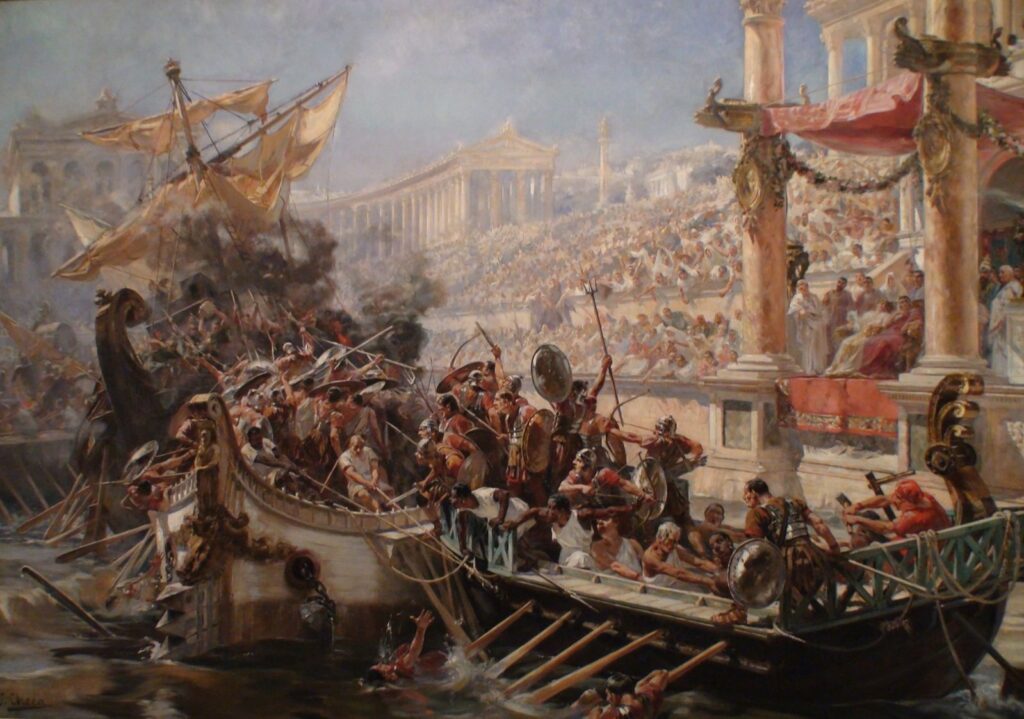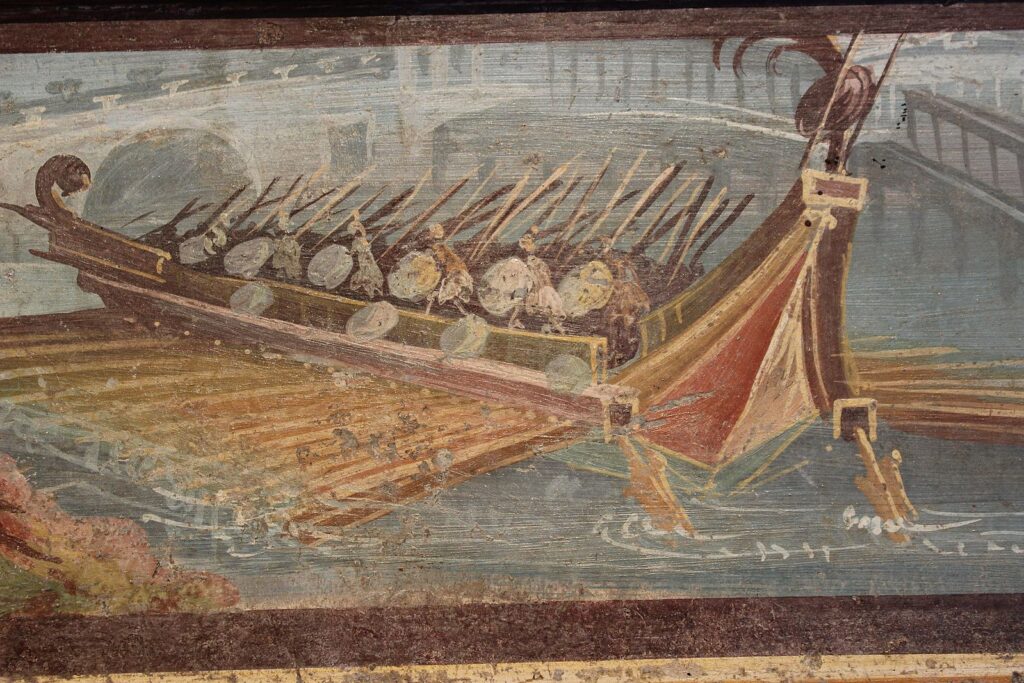There isn’t much that represents ancient Rome quite like the Colosseum. This iconic architectural marvel is instantly recognizable, even in its fractured present form.
Images of gladiatorial battles come to mind when the Colosseum is mentioned. But it was also host to another strange sort of spectacle loved by the ancient Romans–naval battles.
In a feat of engineering genius, the ancient Romans were able to fill the massive Colosseum with water and place ships within. There, they would battle one another just as if they were on the high seas.
The Roman appetite for entertainment was insatiable. But even so, a Colosseum naval battle is hard to imagine.
So how did these mock naval battles come about, and how did the Romans manage to pull such an event off not just once, but multiple times?

Did Romans Have Naval Battles in the Colosseum?
Naumachia
Not only did Rome genuinely host naval battles in the Colosseum, but they actually used it for one on its opening day!
Roman-staged naval battles actually predated the Colosseum by quite some time. These were called naumachia, which translates to “naval combat.”
The first mock maritime fights came to be when Julius Caesar made his return to Rome after a major military victory. The first naumachtia was held as part of his celebration.
The naumachia was a roaring success. The tradition continued, both in natural bodies of water and basins dug specifically for the sport.
They remained popular throughout the decades. As most Roman forms of entertainment were, these mock naval battles were incredibly bloody and violent.
As they did for gladiatorial fights, the Romans used prisoners for their fighters. While the setting for the battles was not the open ocean, the deaths that occurred were very, very real.
Naumachia at the Colosseum
As mentioned earlier, the first naval battle in the Colosseum coincided with its grand opening. Thousands of combatants were said to have participated, and the setting of the show was intricate and wildly dramatic.
These maritime dramas were used to tell stories of legendary sea battles. Whether the participants liked it or not, they were expected to act the part of either the conquering Romans or the enemy they were summarily defeating.
Romans favored drama in their shows, so of course the naumachia were no exception. Ancient sources suggest that the Colosseum’s inaugural naumachia might not have been just theatrical, but also dangerous outside of the battle itself.
This first water battle occurred in 80 AD, just after the completion of the Colosseum. Roman Emperor Titus reigned over the grand spectacle, and no expense was spared.
Cassius Dio writes that a violent rainstorm came down on the battle. This led to the death of all the participating combatants.

How Did the Romans Have Naval Battles in the Colosseum?
Using an arena on dry ground to host a maritime drama might seem impossible. However, innovation was the bread and butter of the ancient Romans.
A lot of different modifications to a normal ship design were needed, along with a plan to be able to fill the Colosseum with water without it immediately just pouring out.
Here are some of the amazing innovations that went into the naumachia at the Colosseum:
Life-size, flat-bottom ships
The water inside the Colosseum obviously couldn’t reach ocean-worthy depth. In fact, when it was filled, the false ocean was only a few feet deep.
To make up for this while also having life-sized battleships, the ships had to be constructed with flat bottoms.
It wasn’t enough to have them stationary–the ships needed to be able to be sailed or rowed during the mock battle. The flat bottoms helped accomplish this.

Filling the Colosseum
While there aren’t any exact texts describing how the Colosseum was filled, experts have been able to piece together a way in which the Colosseum might have become a pool.
A vast system of aqueducts and pipes was present under the Colosseum. The hypothesis is that these chambers and pipes were used to both fill and empty the arena on command.
By this time in history, the ancient Romans were already using pipe systems to supply the city with water, reminiscent of modern plumping. Forty or more input channels or canals would have run from the Tiber River to the Colosseum, which would then be filled when needed.
Since the aforementioned boats were created with a flat bottom, they were able to use the smallest amount of water possible to minimize how much effort the endeavor would take.
Intricate and elaborate sets
It wasn’t just the logistics of the Colosseum naumachia that made it something legendary.
While the area itself was undoubtedly impressive, especially when filled with water, the sets used for the shows were incredible in their own right. The ships themselves would be crafted down to the finest detail to match true Roman naval ships.
Even more impressive were the islands and ports that would be built to flesh out the naval battles. The fighting itself was all too real for the combatants.
While there wasn’t as much room to maneuver inside the Colosseum as there was in the outdoor naumachia venues, the carefully crafted ships were still able to ram each other in the spirit of true battle.
The End of Naumachia
Naval battles in the Colosseum were grandiose, but they were also incredibly complicated and costly shows to put on. Once the Romans proved that it was possible, naumachia in the arena settings slowly fell out of favor.
That isn’t to say they stopped altogether, though. Purpose-built naumachia basins, similar to man-made lakes, became the more popular setting for mock naval battles.
They were significantly cheaper to maintain. These basins could also be made much deeper, allowing for more dramatic battles.
Unfortunately, the end of the naval battles both in the Colosseum and in other places came about. They just weren’t as exciting as other gladiator competitions and animal battles that the Romans adored.
As impressive as these naumachia were, they lacked the one thing that seemed to entertain the ancient Romans more than anything else–graphic bloodsport.
References
“The Naumachiae of Titus and Domitian”
https://penelope.uchicago.edu/~grout/encyclopaedia_romana/gladiators/naumachiae.html
“Romans Once Filled the Colosseum with Water and Staged an Epic Mock Sea Battle”

